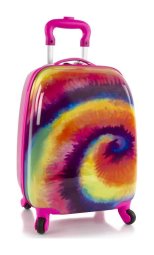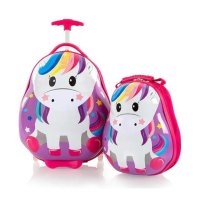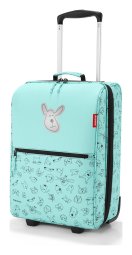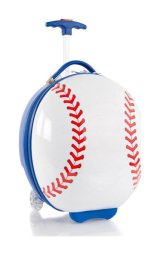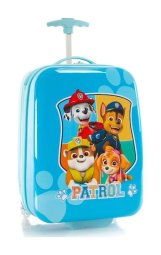Travelling with children is both fun and challenging. However, the right luggage can make it significantly more pleasant for both parents and young travellers. A kids' trolley suitcase offers, in addition to easy transport, a unique opportunity to involve children in travel preparations and teach them the basics of independence. Getting a suitable suitcase can also help create a positive relationship between the child and travelling, turning packing into a fun activity. In this article, we will advise you on what to focus on when choosing a suitcase for children, so that it meets your expectations as well as the needs of your little ones.
Contents
- Why Choose a Kids' Suitcase
- Key Features for Choosing a Kids' Suitcase
- Types of Kids' Suitcases
- Kids' Suitcases and Travel: Practical Tips for Parents
- Price/Performance Ratio
- Frequently Asked Questions (FAQ)
- Conclusion and Summary
Why Choose a Kids' Suitcase?
A kids' travel suitcase is an ideal tool to teach a child to organize, look after, and take care of their things. Children learn by observing their surroundings, so their closest ones often become their role models. A suitcase received from parents or grandparents can be not only a source of joy but also a great motivation to become part of the entire travel process.
Having their own suitcase gives a child a sense of importance and independence. When a child packs their things into a suitcase with a picture of their favourite character from a film or series they like, they will look forward to the trip more. Having their own luggage means being able to prepare and pack what they will take with them, which develops their planning and decision-making skills. With a suitcase, children can also improve their physical fitness when they pull or carry it, and practice fine motor skills when opening zips and packing or unpacking their gear.
Key Features for Choosing a Kids' Suitcase
Size and Volume
The length of the journey and the age of the child are crucial for selection.
For young children, who usually travel with their parents, small suitcases with a volume of up to 20 litres are suitable, fitting just a few basic necessities, including a favourite toy or a travel pillow.
Older children and pre-schoolers will appreciate larger and more spacious models in the range of 20–30 litres, where they can store, in addition to clothes and shoes, a toy or a book for long moments.
Teenagers (boys and girls) have higher demands not only on appearance but also on space and the internal layout of the luggage. Since it is expected that they may already be travelling independently, for example, on a school trip or to their grandparents for the holidays, they will appreciate suitcases with a larger number of pockets and a volume of 30 litres and more, which can hold gear for a multi-day stay away from home, including basic toiletries.
Kids' suitcases, with their dimensions, meet the cabin luggage standards of most airlines, so you don't have to worry about check-in fees.
Weight
The weight of a travel suitcase has a major impact on how difficult it will be to handle, so it should be proportional to the child's physical abilities. The weight of an empty suitcase should not exceed 2 kg. Generally, children can manage to pull lighter suitcases themselves, or hold or carry them for a short time without being overloaded. Especially with younger children, it is desirable for the suitcase to be sufficiently light even when full.
Material
This plays an important role in how well the suitcase can protect things during transport and how long it will last without major signs of wear. The material also directly affects the weight of the suitcase.
Kids' hardshell suitcases made of plastic are generally more resistant to impacts, are low-maintenance, but are slightly heavier than fabric ones. They do not have front pockets.
- Polycarbonate (PC) – a strong and flexible polymer resistant to impacts, usually with a glossy surface, but can also be matte, high-quality prints can be applied to it
- ABS – a hard plastic with minimal flexibility but considerable resistance to mechanical damage, often combined with polycarbonate to achieve the best properties
Kids' softside suitcases made of fabric are lighter, more flexible for packing, have external pockets for small items, and you can easily pull out what you need during the journey.
- Polyester (PES) – a lightweight synthetic fabric, resistant to UV radiation and moisture, does not wrinkle, retains its shape and colour, can be woven in several ways, the fineness and density of the weave are given in denier units
Wheels
Kids' travel suitcases can have either two or four wheels. Manufacturers use several types – from simple all-plastic ones to in-line wheels and plastic wheels with a rubber coating.
2 wheels
- Advantages: They stand stably even on uneven surfaces and are largely covered by the bottom of the suitcase; thanks to their simple construction, they are less prone to mechanical damage.
- Disadvantages: The suitcase can only be pulled behind, poorer ability to avoid obstacles
4 wheels
- Advantages: They allow for smooth movement in all directions, ideal for easily pushing the suitcase alongside or in front of you.
- Disadvantages: On sloping or uneven terrain and when riding in public transport, they can start moving on their own; their placement and number can slightly increase the risk of damage during transport.
TIP: Double wheels (spinner wheels) will provide better stability and weight distribution of the load.
Telescopic Handle
The telescopic handle is usually made of durable and lightweight metal. It should have an adjustable height and an ergonomic handle with a locking mechanism, so that it is easy for children to hold and can be easily extended and retracted.
Expander
Some suitcases are equipped with a perimeter zip, which can be unzipped to increase the storage volume by several litres.
Zip and Lock
The suitcase should have a quality zip with pullers that are easy for a child to grip. If there are times when you don't have the suitcase under 100% supervision, it is advisable to lock it with an integrated lock. If the suitcase is not directly equipped with one, you can purchase a padlock, which you thread through special eyelets on the zip sliders to fasten them together.
Interior
Kids' softside suitcases have only one main compartment. Kids' hardshell suitcases with a clamshell packing system have the interior divided into two parts. One has a fabric divider with a zip, the other has packing straps. The interior may include zip pockets and compartments for small items. A colourful fabric lining and an integrated name tag are also standard.
Appearance
Choose a design that will delight the child, whether it's a fairy-tale character, a favourite animal, or a simple colourful pattern. The design is important not only for motivation but also for practical use, as it can help the child recognize their luggage among others at a glance.
Types of Kids' Suitcases
Kids' Softside Suitcase
- lighter than a hardshell suitcase
- suitable for younger children and children of small stature
- often has a front pocket for small items
Kids' Hardshell Suitcase
- impact-resistant, more suitable for longer journeys, e.g. by plane
- sturdier construction for better protection of items inside
- can handle a heavier load
Kids' 2-Wheeled Suitcase
- provides more storage space than four-wheeled suitcases of the same dimensions
- lower weight compared to four-wheeled suitcases
- more stable construction, better at handling uneven surfaces, curbs, and stairs when being pulled
- ideal for children who are just starting to travel and move with a suitcase
Kids' 4-Wheeled Suitcase
- makes it easier to move on smooth surfaces at the airport and in the hotel
- four spinner wheels allow for movement in all directions
- ensures flexible handling when navigating obstacles and the ability to react quickly
Kids' Ride-On Suitcase
- sturdy construction with a guaranteed weight capacity, designed for children to sit and ride on
- can be used as a ride-on toy, carried by hand, or pulled along on the included strap
- playful design, cheerful motifs, and an easy way to pack and transport
Kids' Suitcase and Backpack Set
- a kids' suitcase and a kids' backpack in the same design
- offers greater capacity and flexibility in packing
- clothes, shoes, and other important items go in the suitcase, while the backpack serves as carry-on luggage for snacks, a toy, and whatever needs to be kept close at hand
- ideal for families looking for a complete and practical travel solution
Popular Brands of Travel Suitcases for Kids
- Heys – stylish and durable softside and hardshell kids' suitcases on two or four wheels with their own and licensed designs for girls and boys
- Reisenthel – two-wheeled softside suitcases in solid colours with animal motifs that both younger and older boys and girls will love
- Travelite – girls' and boys' two-wheeled and four-wheeled softside kids' suitcases with a side pocket for a drink bottle in traditional colours (blue and pink) with traditional images
Kids' Suitcases and Travel: Practical Tips for Parents
-
- Involve the child in packing: Children will learn to prepare and organize their things and will also enjoy the preparation for the trip. Packing helps develop independence, coordination, decision-making skills, and a sense of responsibility.
- Use organizers: Packing cubes for clothes, shoe covers, waterproof bags for swimwear, and a bag for dirty laundry will ensure clarity, organization, and hygienic storage.
- Consider the weight: Kids' suitcases should be as light as possible, both before and after being filled, so that children can move them themselves. Especially at airports or train stations, where there are crowds of people, it is necessary to react quickly, change direction, and speed of movement.
- Check the dimensions: Check whether the suitcase meets the cabin luggage limits of the respective carrier or carriers. The maximum permitted dimensions and weight of carry-on luggage can vary significantly between airlines.
TIP: Do you really only have items in your carry-on that you are allowed to take on board?
Price/Performance Ratio
The price of kids' suitcases ranges from €60 to €120. More expensive models are usually made from materials that are more resistant to mechanical damage, or they have more functional features, which can be a great advantage for families with children who travel very often. The prices of kids' suitcases can also be influenced by licensed prints, which are protected by copyright and can only be used with the consent of their owner (e.g., Disney, Dreamworks, Marvel, Hello Kitty).
Frequently Asked Questions (FAQ)
How to choose the right size kids' suitcase?
The size of the suitcase should correspond to the child's age and the length and difficulty of the trip. Smaller suitcases are suitable for shorter trips, while larger models are better for longer journeys and holidays.
Is a plastic or fabric suitcase better for children?
Plastic suitcases are more resistant to impacts, making them more suitable for transporting fragile items by plane or in the luggage compartment of a train or bus. Fabric suitcases are lighter and more compact, have external pockets, and their contents are more easily accessible during travel.
Are kids' suitcases suitable as carry-on luggage?
Yes, most kids' suitcases meet the carry-on luggage requirements of airlines. It is recommended to check the specific dimensions/limits of the respective airline before travelling.
What is the best suitcase for a toddler (1-3 years)?
For a toddler, the best choice is a lightweight suitcase with a cheerful picture on two or four wheels with an adjustable handle that matches the child's height.
What type of wheels is better for a kids' suitcase?
Two durable plastic wheels are a better choice for terrain and uneven surfaces. Four spinner double wheels are ideal for smooth surfaces at the airport and on flat city pavements, where you need to change direction quickly and avoid collisions with passers-by.
How to involve a child in packing a suitcase?
The child can help choose their clothes, slippers, and toys. You can turn packing into a game or a competition. This way, children learn to organize their things in a playful manner, and you will have an overview of what has already been packed.
Can I wash a kids' suitcase?
Neither hardshell nor softside suitcases can be washed. If they get dirty, you can wipe them with a damp cloth; a soap solution and a sponge can be used to clean stubborn stains.
Does a kids' suitcase have any reflective elements?
Softside suitcases may be equipped with sewn-on reflective strips or embroidery, or a reflective print to increase the child's safety.
Is there a suitcase that children can also use as a ride-on?
Yes, Heys Ride-On kids' suitcases with four light-up wheels, a sturdy construction, and a max. weight capacity of 50 kg are designed so that children can ride on them in their free time or pull them along with a strap.
What are the most popular designs on kids' suitcases?
Young children love pictures of animals – cats, dogs, pandas, tigers, bears, and unicorns. Older children prefer designs with characters and heroes from animated series and films they watch on TV. Very popular are Peppa Pig, Paw Patrol, My Little Pony, and Trolls.
Conclusion and Summary
Choosing a kids' trolley suitcase is not difficult when you know what to focus on. It is important to find the optimal balance of storage space size, functional equipment, and a design that will excite the child. Choose a lightweight suitcase made of durable material, with a number of wheels that will truly match the abilities and age of your child, as well as the needs of your family on the go. A well-chosen kids' travel suitcase will support the independence and responsibility of your little ones and turn your holiday, weekend trip, summer camp, or holidays at grandparents' into a real adventure. Travelling with their own suitcase is an experience for children that they will remember for a lifetime. So, be happy to give it to them!


